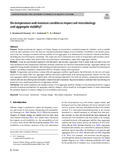JavaScript is disabled for your browser. Some features of this site may not work without it.
| dc.contributor.author | Dowdeswell-Downey, Emily | |
| dc.contributor.author | Grabowski, Robert C. | |
| dc.contributor.author | Rickson, R. Jane | |
| dc.date.accessioned | 2023-08-30T08:59:50Z | |
| dc.date.available | 2023-08-30T08:59:50Z | |
| dc.date.issued | 2023-08-29 | |
| dc.identifier.citation | Dowdeswell-Downey E, Grabowski RC, Rickson RJ. (2023) Do temperature and moisture conditions impact soil microbiology and aggregate stability?, Journal of Soils and Sediments, Volume 23, Issue 10, October 2023, pp. 3706-3719 | en_UK |
| dc.identifier.issn | 1439-0108 | |
| dc.identifier.uri | https://doi.org/10.1007/s11368-023-03628-2 | |
| dc.identifier.uri | https://dspace.lib.cranfield.ac.uk/handle/1826/20149 | |
| dc.description.abstract | Purpose: Studies predicting the impacts of climate change on erosion have considered numerous variables, such as rainfall erosivity and vegetation cover, but have not considered potential changes in soil erodibility. Erodibility is an intrinsic property of the soil, strongly correlated with the stability of soil aggregates. It is influenced by soil physico-chemical attributes, including the microbiological community. The study aim was to determine how shifts in temperature and moisture conditions, which other studies have shown affect microbiological communities, might affect aggregate stability. Methods: Using an experimental approach with laboratory microcosms, aggregates from a sandy loam soil and a clay soil were incubated at three temperatures and three moisture conditions in a factorial experimental design. Aggregate stability was quantified using rainfall simulation. Microbiological indicator metrics were measured to evaluate treatment microbiological impacts, including community composition (PLFA), biomass carbon, and respiration. Results: Temperature and moisture content affected aggregate stability significantly, but differently for the two soil types tested. For the sandy loam soil, aggregate stability decreased significantly with increasing moisture content. For the clay soil, aggregate stability increased significantly with increasing temperature. For both soil textures, temperature and moisture content affected microbiological community composition and respiration. Regression analysis indicated that microbiological properties were significant predictors of aggregate stability. Conclusion: Our results emphasise the dynamic nature of soil aggregate stability. Changes in microbiological metrics suggest possible biological mechanisms for aggregate stability changes, which should be investigated further to better understand the potential impacts of climate change on soil erodibility and erosion. | en_UK |
| dc.description.sponsorship | Natural Environment Research Council (NERC): NE-M009106-1 BBSRC | en_UK |
| dc.language.iso | en | en_UK |
| dc.publisher | Springer | en_UK |
| dc.rights | Attribution 4.0 International | * |
| dc.rights.uri | http://creativecommons.org/licenses/by/4.0/ | * |
| dc.subject | Soil erosion | en_UK |
| dc.subject | Erodibility | en_UK |
| dc.subject | Climate change | en_UK |
| dc.subject | Microbial community | en_UK |
| dc.subject | Biostabilisation | en_UK |
| dc.title | Do temperature and moisture conditions impact soil microbiology and aggregate stability? | en_UK |
| dc.type | Article | en_UK |
| dc.identifier.eissn | 1614-7480 |
Files in this item
The following license files are associated with this item:
This item appears in the following Collection(s)
-
Staff publications (SWEE) [2838]

